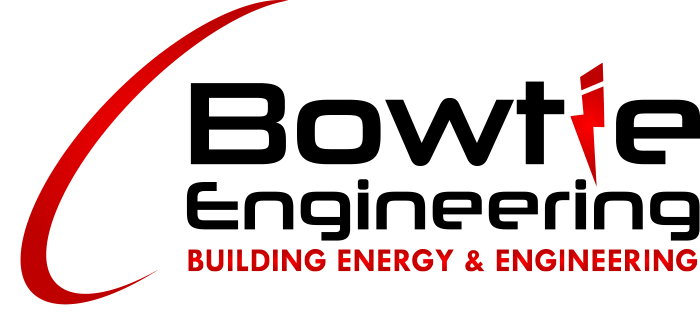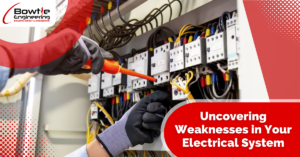BENEFITS OF READING THIS BLOG
- Enhanced Safety Awareness: Learn how to identify and address potential hazards in your electrical system, ensuring a safer environment for you and your property.
- Risk Mitigation Knowledge: Acquire insights into proactive measures to prevent system failures, minimizing downtime and potential damage.
- Improved Reliability: Understand the vulnerabilities that can compromise your electrical infrastructure and discover ways to enhance its overall reliability.
- Compliance Assurance: Ensure your electrical system aligns with safety standards, avoiding legal and regulatory issues while maintaining a secure setup.
- Educational Value: Gain practical knowledge through case studies and a step-by-step guide, empowering you to conduct effective audits and make informed decisions.
Introduction:
In the dynamic landscape of electrical systems, identifying and addressing weaknesses is paramount for safety, reliability, and compliance. “Uncovering Weaknesses in Your Electrical System” delves into the critical aspects of electrical infrastructure, offering insights to enhance your system’s resilience. By reading this blog, you’ll gain a profound understanding of common vulnerabilities, tools for system audits, and practical risk mitigation strategies. Elevate your electrical safety awareness and fortify your system against potential failures by exploring the valuable knowledge presented here.
Understanding Electrical System Weaknesses
Before delving into the intricacies of identifying weaknesses, it’s essential to recognize the common vulnerabilities present in electrical systems. These vulnerabilities can manifest in various forms, from outdated components to inadequate maintenance practices. A lack of awareness regarding these weaknesses can lead to system failures, outages, and, in extreme cases, pose serious safety risks.
One of the primary vulnerabilities lies in the age and condition of electrical components. Over time, equipment can degrade, leading to increased resistance, overheating, and potential breakdowns. Additionally, inadequate installation practices and suboptimal design can create weak points within the system, amplifying the risk of failures.
Conducting a System Audit
To effectively uncover weaknesses in your electrical system, a systematic audit is necessary. This involves a comprehensive examination of all components, infrastructure, and maintenance practices.
Step-by-step guide to assessing your electrical setup:
Inspecting Components: Begin by examining each component of your electrical system. Look for signs of wear, corrosion, or any visible damage. Pay particular attention to cables, switches, and circuit breakers.
Testing for Resistance: Utilize appropriate tools to measure the resistance in electrical circuits. Elevated resistance levels can indicate potential weaknesses and the need for further investigation.
Thermal Imaging: Incorporate thermal imaging to identify areas of excessive heat. Overheating is a clear indicator of potential weaknesses that may lead to equipment failure.
Tools and technologies for a comprehensive audit:
Multimeters: Measure voltage, current, and resistance accurately.
Infrared Cameras: Detect variations in temperature, highlighting potential issues.
Power Quality Analyzers: Monitor and analyze the quality of electrical power, identifying irregularities.
A comprehensive audit not only helps in identifying existing weaknesses but also serves as a preventive measure by addressing potential issues before they escalate.
Risk Mitigation Strategies
Once weaknesses are identified through a thorough audit, the next crucial step is implementing risk mitigation strategies. These strategies are designed to enhance the resilience of your electrical system, minimize the probability of failures, and ensure compliance with safety standards.
Implementing preventive maintenance:
Regular maintenance is the cornerstone of a robust electrical system. Establishing a routine maintenance schedule that includes inspections, cleaning, and component replacements can significantly reduce the likelihood of unexpected failures. This proactive approach not only enhances system reliability but also extends the lifespan of critical components.
Upgrading outdated components:
Outdated components pose a significant risk to the overall integrity of an electrical system. Consider upgrading obsolete equipment to modern, more efficient alternatives. This not only improves performance but also aligns the system with current safety and energy efficiency standards.
Ensuring compliance with safety standards:
Adherence to safety standards is non-negotiable in maintaining a secure electrical environment. Regularly review and update your system to comply with the latest safety regulations and industry standards. This not only mitigates risks but also safeguards against legal and regulatory implications.
Case Studies
To illustrate the real-world consequences of overlooking weaknesses in electrical systems, let’s examine a couple of case studies where system failures had significant impacts.
Citywide Outage Due to Aging Infrastructure:
In a bustling urban center, an aging electrical infrastructure went unnoticed until it reached a critical point. Overloaded circuits, outdated transformers, and deteriorating cables led to a citywide outage. The economic repercussions were substantial, with businesses facing prolonged downtime and residents grappling with the inconvenience of disrupted services.
Lessons Learned: Regular inspections and timely upgrades could have prevented this widespread outage. Proactive measures are key to avoiding such large-scale disruptions.
Industrial Plant Fire Caused by Electrical Fault:
In an industrial setting, a fire broke out due to an electrical fault that went undetected. The consequences were severe, with damage to machinery, loss of production, and, most critically, risks to the safety of workers on-site.
Lessons Learned: Regular thermal imaging and preventive maintenance could have identified the electrical fault before it escalated into a fire, preventing both financial and human losses.
These case studies underscore the importance of not only identifying weaknesses but also taking decisive actions to address them promptly.
Educational Resources and Further Reading
Knowledge is a powerful tool in the quest to strengthen your electrical system. To further empower readers, we’ve compiled a list of educational resources and additional readings on electrical system maintenance, safety, and best practices.
IEEE Standards for Electrical Safety:
Explore the comprehensive standards provided by the Institute of Electrical and Electronics Engineers (IEEE) to ensure your system aligns with industry best practices.
NFPA 70E – Standard for Electrical Safety in the Workplace:
The National Fire Protection Association (NFPA) provides guidelines for electrical safety in the workplace, covering everything from equipment maintenance to employee training.
Online Courses and Training Programs:
Platforms like Coursera, Udemy, and LinkedIn Learning offer a range of courses on electrical system maintenance, providing in-depth insights for professionals and enthusiasts alike.
Conclusion
In conclusion, the proactive identification and mitigation of weaknesses in your electrical system are paramount for ensuring safety, reliability, and compliance. By understanding common vulnerabilities, conducting systematic audits, implementing risk mitigation strategies, and learning from real-world case studies, you can fortify your electrical infrastructure against potential failures. As technology advances and our reliance on electricity deepens, the need for a resilient electrical system becomes increasingly critical. It is not only a matter of functionality but a fundamental aspect of safeguarding lives, property, and the seamless operation of our interconnected world. Embrace the knowledge presented in this guide, take proactive steps to strengthen your electrical system, and empower yourself to navigate the electrified future with confidence.
 Skip to content
Skip to content 

